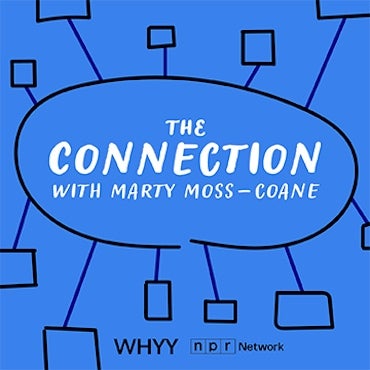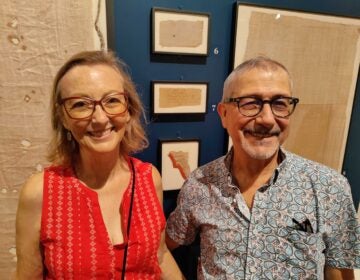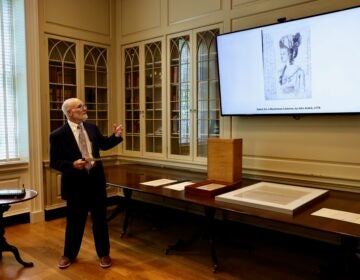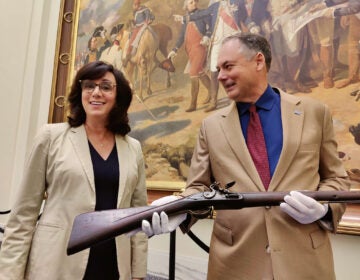A calfskin wallet made from a Revolutionary War drumhead is coming to the Museum of the American Revolution
After appearing on “Antiques Roadshow,” descendants of a Revolutionary soldier have donated artifacts to the Museum of the American Revolution.
Listen 1:22
"Antiques Roadshow" appraiser Joel Bohy talks with Nanette Osborne, assessing personal documents from the Revolutionary War held in her family for almost 250 years. ("Antiques Roadshow")
From Philly and the Pa. suburbs to South Jersey and Delaware, what would you like WHYY News to cover? Let us know!
The personal effects carried by a soldier during the American Revolutionary War, which earlier this year were featured on the PBS program “Antiques Roadshow,” are now on display in Philadelphia at the Museum of the American Revolution.
In 1776 and 1777, Lieutenant Samuel Gerock of Lancaster, Pennsylvania, fought in the Battles of Trenton and Princeton while carrying a pocket almanac he bought in Philadelphia. On the blank pages of that almanac, he kept a diary and sketched a map of a later skirmish in Spanktown, New Jersey, which is now Rahway.

After the battles, Gerock picked up a damaged calfskin drumhead from his unit’s drummer and crafted it into a crude leather wallet. He wrapped the almanac in the wallet and documented the battles during which the drumhead was played on the calfskin itself.
He later used these artifacts to prove his combat service to obtain a soldier’s pension.
James Taub, an associate curator at the Museum of the American Revolution, is unaware of any other visual documentation of the battle at Spanktown, which was part of the Forage Wars. He calls it a “once-in-a-lifetime” find.
“This is a key part of American history, one of the few witnesses both as an object and as the written description from a person who witnessed these events that is known to still exist,” he said. “It’s amazing that it’s made it through 250 years, almost.”

The almanac, drumhead and cache of letters written during and immediately after the war were kept in the Gerock family for generations. Ultimately, they landed in the hands of Nanette Osborne, a direct descendent, and her husband Jim in Greensboro, North Carolina.
The Osbornes have no other objects that belonged to Nanette’s ancestor, and they do not collect historic artifacts. Nanette first saw the drumhead wallet as a girl in her grandmother’s house.
“My grandmother really loved history and really cared about things, and of course, nobody in our family ever throws anything away,” Nanette said. “We were talking to Jim’s sister and she said that she was so happy I’m the one that ended up with this artifact because if it was her, she would have thrown it out a long time ago.”

When “Antiques Roadshow” recently shot an episode in Raleigh, North Carolina, Jim urged his wife to bring out the wallet.
“I was the one who convinced her to go on “Antiques Roadshow.” She would not have done it otherwise,” he said. “I thought it was pretty extraordinary to have a drumhead from the Battle of Trenton and Princeton. The world needs to see this.”
Appraiser Joel Bohy, an “Antiques Roadshow” specialist in military artifacts, selected the Gerock wallet, almanac and letters for a segment on the show. He revealed that it could be worth $10,000 to $15,000 at auction, and suggested it be insured for $25,000.
But instead of selling, the Osbornes decided to give it away.
“I thought it wasn’t fair for me to make money on it,” Nanette said. “There are other descendants. Why should I be the one to profit?”
Nanette briefly considered donating the bundle to a North Carolina Revolutionary War site, where her ancestor lived and is buried. However, on Bohy’s advice, the Osbornes approached the Museum of the American Revolution in Philadelphia instead.
“After we researched the museum, I just thought it was a great place,” Nanette said. “And the fact that the little almanac was from Philadelphia — it was bought in Philadelphia — just seemed like a really cool connection.”

The Museum of the American Revolution has temporarily displayed the drumhead and almanac artifacts near its showcase object, General George Washington’s field tent. They will be on view there for several months.
The letters included in the Osborne donation are particularly interesting to curator Taub. During the second Battle of Trenton and the Battle of Princeton, Lieutenant Gerock became the unit commander, as its regular commander had to be in Philadelphia. In that role, he had direct communication with other commissioned officers with whom he often exchanged letters.
Taub said the letters get a little catty.
“I’ve been calling it the Real Housewives of the Continental Army, because there’s some drama in these papers,” he said. “These officers are complaining about one another and talking about one another behind each other’s backs in these letters.”

Taub and the museum have scanned all the elements of the donation — including the letters — and posted them with transcriptions to their webpage, free and accessible to anyone online.
“It’s not only incredibly generous of the Osbornes to make this a donation to the museum, but they’re giving it to the country as a whole,” he said. “They’re giving it to everyone living today to be able to see this.”

Get daily updates from WHYY News!
WHYY is your source for fact-based, in-depth journalism and information. As a nonprofit organization, we rely on financial support from readers like you. Please give today.






